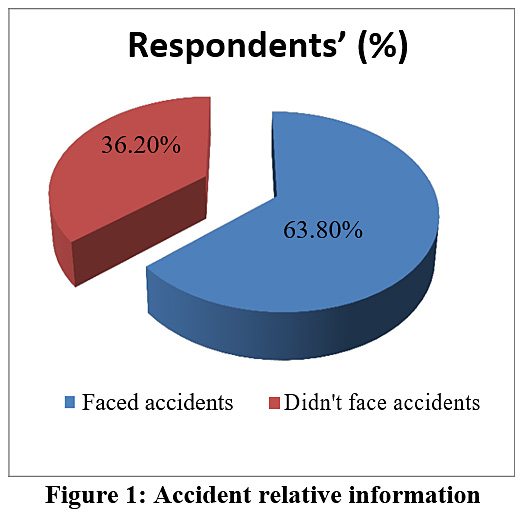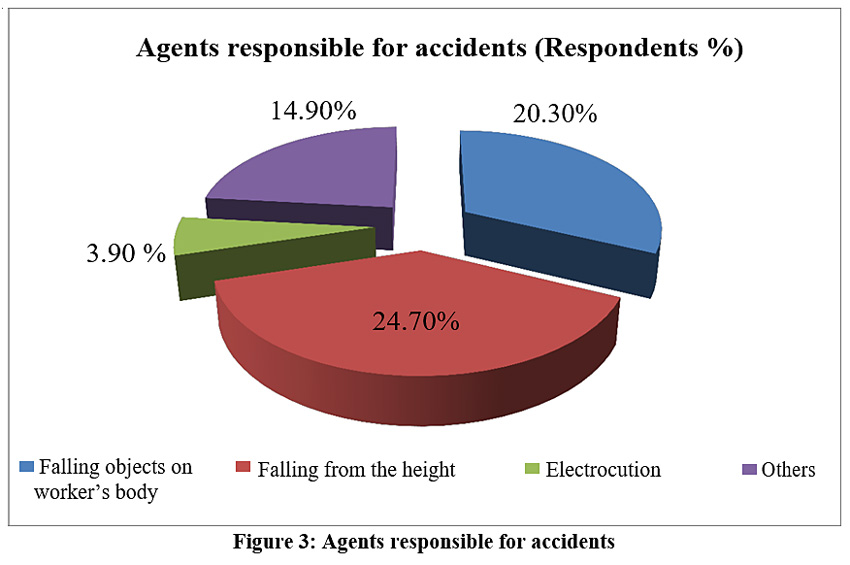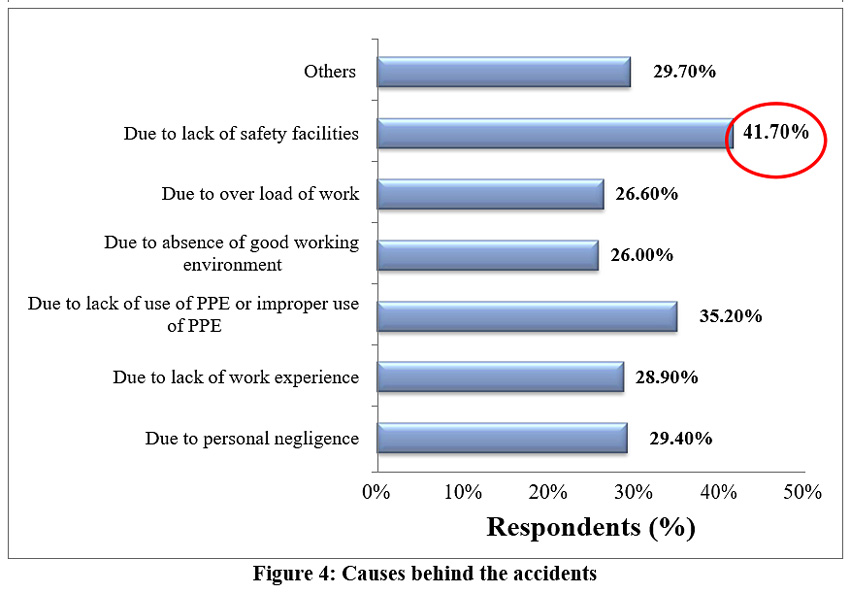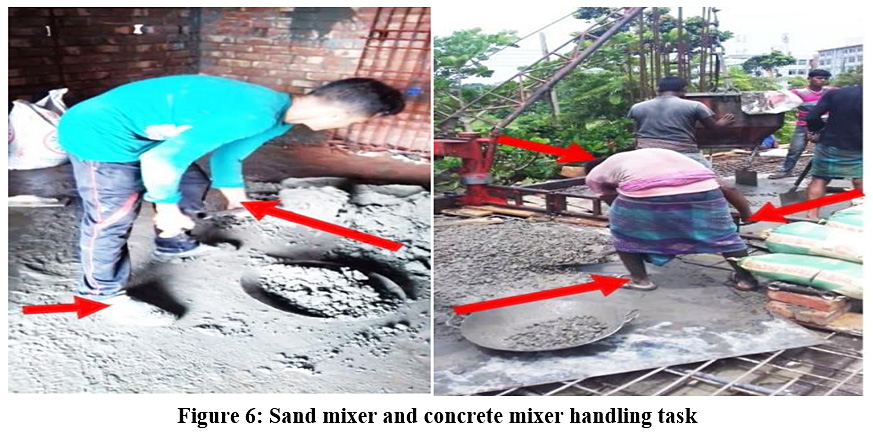Prevalence of Accidental Injuries among Building Construction Workers in Bangladesh
Corresponding author Email: sumon.just16@gmail.com
DOI: http://dx.doi.org/10.12944/CWE.15.1.07
Copy the following to cite this article:
Rahman M S, Ahmed S. M. T, Karmaker C. L, Roy R. Prevalence of Accidental Injuries among Building Construction Workers in Bangladesh. Curr World Environ 2020; 15(1). DOI:http://dx.doi.org/10.12944/CWE.15.1.07
Copy the following to cite this URL:
Rahman M S, Ahmed S. M. T, Karmaker C. L, Roy R. Prevalence of Accidental Injuries among Building Construction Workers in Bangladesh. Curr World Environ 2020; 15(1). Available from: https://bit.ly/2RlISGG
Download article (pdf) Citation Manager Publish History
Select type of program for download
| Endnote EndNote format (Mac & Win) | |
| Reference Manager Ris format (Win only) | |
| Procite Ris format (Win only) | |
| Medlars Format | |
| RefWorks Format RefWorks format (Mac & Win) | |
| BibTex Format BibTex format (Mac & Win) |
Article Publishing History
| Received: | 02-12-2019 |
|---|---|
| Accepted: | 12-03-2020 |
| Reviewed by: | 
 Madhu Gopal
Madhu Gopal
|
| Second Review by: |

 Gaurav Dhawan
Gaurav Dhawan
|
| Final Approval by: | Dr Gopal Krishan |
Introduction
The construction industries play an important role in country development. Generally, construction workers perform their activities in open sky, various weather conditions as well as unsafe workplaces. That is why the construction workers around the world face various occupational injuries.1 Tahir et al.,2 depicted that, construction sectors as industry having the capability of making different risks and perils to agents with the capacity of bringing about injuries or demise. Subsequently, different dangers, work-related threats, accidents, and injuries are an overwhelming event for workers in the construction sectors.3
Therefore, the building construction tasks (mixing sand, lifting and carrying materials, bricklaying, plastering, concrete laying, painting, etc..) poses serious dangers, safety issues to the workers around the world.4 The accidental injuries among building construction workers have become a common phenomenon. Accidental injury refers to an injury that the outcome of an unexpected and unfortunate catastrophe. The most common accident occurs in the building construction workers site due to falling the workers from the height, falling objects, electrocution, slip and falls, scaffolding accidents, power tool, and machinery, ladder accidents, etc. The accidents in construction sites cause a number of severe injuries. Frequently workplace accidents cause to workers death. The accident also causes injuries, partial or permanent disablement to the workers. Some of the accidental injuries occure in construction workers are: broken or fractured bones, burns from fires or electrocutions, cuts from machinery or tools, shoulder, knee or ankle pain, spinal cord damages from falls, brain injuries, etc. Accidental injuries in construction workers are not only a local problems but also a global problems. Comparing other industries, the workers of the construction industry suffer the utmost amount of the risk of workplace injuries and fatality over the world.5 Hamind et al.,6 conducted a study in Malaysia and found the causes behind the accidents among construction workers as wrong working procedures, lack of skills and knowledge, poor location management, improper use of personal protective equipment (PPE), and so on. Wanjo et al.,7 conducted a study on construction workers from 2011 to 2015 in Korea. In this study showed that one of the leading causes of fatality in the Korean construction sector was falling of a person from the height. A total 76% of the industrial accidents in the year 2017 occurred in the construction sector in Hong Kong.8 Amiri et al., (2014)9 reported that the occupational injuries among construction workers found in developing countries more comparing with the developed countries. They also found that, only 14% of workers work in the construction industry and 37% of the total industrial accidents occur in this industry. Yilmaz10 carried out a study in turkey construction workers and revealed that 400 deaths, as well as 400 total disabilities occurred per year due to work-related accidents. They also found the accidental deaths in construction workers are increasing day by day. Prolongation to the above mentioned injuries increase both direct and indirect costs.11 The direct costs are being the expense of protection, hospital expenses, obligation, and property misfortune, and premiums for remuneration benefits, while the indirect costs are the incorporate transportation, time lost in going to entombment functions, time lost in casualty examination, the vacation of damaged equipment and losses emerging from site conclusion.12
As a developing country, the construction industries or high-rise buildings in Bangladesh are increasing day by day. As said by the construction workers Union and Real Estate & Housing Association of Bangladesh (REHAB), about 3.5 million people work in the construction industry of Bangladesh.13 As reported by the International Labor Organization (ILO) approximately 8 million workers faced work-related injuries. Among them construction workers were more than 40%.14 Bangladesh Occupational Safety, Health, and Environment Foundation (OSHE) reported in 2018 that, number of construction workplace deaths and injuries are 163 and 262.15
In light of the proof construction, laborers in Bangladesh are working in a dangerous and unsafe condition. Therefore, the objectives of this study were to investigate the prevalence of accidental injuries among building construction workers in Bangladesh. Authors investigated the several types of injuries and various agents those were responsible for the workplace accident in construction sites. Authors also investigated the lacking factors behind these injuries.
Methodology
Sample Selection
In this study, a total of 390 building construction workers were selected randomly from the different construction sites at Jashore, Bangladesh. The sample size was selected based on the following formula:

Where N is the expected sample size, Z is the statistic corresponding to the level of confidence, P is percentage of picking a choice that expressed as decimal, and C is the confidence interval. The sample size 390 was selected with the 95% level of confidence (LC= 1.96), 50% of picking of a choice and 5% confidence interval (CI). The participant was selected who had at least one year of working experience and the age above 18 years. Among the different types of works authors chosen the participant who performed the only the following tasks like as sand mixing, wall plastering, brick laying, carrying and lifting materials, concrete laying, wall painting, and tiles fitting.
Data Collection and Analysis
Authors collected the data through a face-to-face interview and direct observations. Authors used a structured questionnaire for retrieving the data. The questionnaire had three sections. The first section contained the general information as gender, age, working hours, rest time, working experiences, monthly working days, height, weight, and body mass index (BMI). The second section included to the prevalence of accidents, effect due to accidents, and the agents that are responsible for the accidents. The possible lacking of the constructions environment also included in the third section of the questionnaire. All the questionnaires were two categories as an open-end and yes/no. It took about 15-20 minutes to complete the questionnaire for a single worker. The author collected the data during the worker’s free within day work hours (8 am to 6 pm). The Statistical Package for the Social Sciences (SPSS) version 25 was used to analysis the data.
Results
The general information of the participants in the studied sites is shown in table 1. Among the total participants, 92.82% were male and 7.18% were female. The mean age and working experiences were 34.64 (SD = ±11.63) and 13.05 (SD = ±9.63) years respectively. The mean working and rest hours per day were 9.36 (SD = ±1.08) and 1.12 (±0.26) hours respectively. The mean body mass index (BMI) of the participant was 24.37 kg/m2 (SD = ±2.93). It indicates that most of the worker is in healthy BMI ranges. A BMI within 18.5-24.9 is considered as healthy BMI.16 The mean working days were 27.79 in a month.
Table 1: General information of the participants (N=390)
|
Factors |
Mean (SD) |
|
Male (%) |
362 (92.82%) |
|
Female (%) |
28 (7.18%) |
|
Age (Years) |
34.64 (±11.63) |
|
Working time (Hours) |
9.36 (±1.08) |
|
Rest time (Hours) |
1.12 (±0.26) |
|
Work Experience (Years) |
13.05 (±9.63) |
|
Weight (kg) |
63.46 (±7.09) |
|
Height (meters) |
1.62 (±0.08) |
|
Body Mass Index(kg/m2) |
24.37 (±2.93) |
|
Monthly working days |
27.79 (±1.92) |
Accidental injury refers to an injury that the outcome of an unexpected and unfortunate catastrophe. An accident is a common occurrence in the construction workers in Bangladesh.
The accidents in the construction site cause a number of severe injuries. Frequently workplace accidents cause workers death. The accident also causes partial or permanent disablement to the workers. In this study, authors observed that most of the workers (63.80%) faced accidents during their job experiences. About 36.20% of workers did not face any accidents (Figure-1).
 |
Figure 1: Accident relative information Click here to view Figure |
The workers who faced accidents had also met different types of physical problems. Figure 2 shows the different accidental effects of the workers. The construction workers suffer from different types of accidental injuries. Int his study, workers (30.20%) reported that they suffered different types of musculoskeletal injuries due to workplace accidents. It included as broken or fractured bones, burns from fires or electrocutions, cuts from the machinery or tools, shoulder, knee or ankle pain, spinal cord damages from falls, brain injuries, etc.
Total 26.30% of the workers were partially disablement through accidents in construction sectors. Due to partial disablement, the workers lose the physical capacity to perform the work for temporary or permanent period. The most common partial disablement in construction workers are back injuries, amputation, carpal tunnel disorder.
 |
Figure 2: Problems due to accidents Click here to view Figure |
On the other hand, 7.30% of the workers reported they were permanent disablement for the worksite accidents. The permanent disablement refers to the long-lasting disablement or injuries in permanent than temporary conditions. Due to parmenent disablement, the workers lose the full physical capacity to perform the work trough out his lifetime.
There may be various agents for accidents in the construction sites. In this study, authors considered only the four main agents. Among the 20.30% of the total workers faced accidents by falling objects on his body. Due to lack of proper safety facilities in construction site, various objects fall on worker’s body. About 24.70% of workers faced accidents by falling from a height. Workers may fall from height due to slip, unawareness, lack of experiences, improper working conditions. In building construction, workers use the electricity to drive the motorized machine. Electrocution is one of the crucial agents for construction site accidents. In this study, a few workers (3.90%) reported that they faced accidents by electrocution. Due to electrocution, workers suffer from different types of injuries. Only 14.90% of workers faced accidents by other agents such as inserting the rod, cut by tools, etc. (figure-3).
 |
Figure 3: Agents responsible for accidents Click here to view Figure |
A question was provided to the workers for identifying the main causes of accidents. Figure-4 shows the response of the workers. Among all causes behind the accidents, workers (29.40%) responded as due to personal negligence. As a hazardous condition, the construction workers should alert all-time in their work. Small negligence may cause a vital issue.
 |
Figure 4: Causes behind the accidents Click here to view Figure |
New and unskilled workers face more accidents than skilled workers do. As a result, 28.90% of respondents reported unskilled workers frequently faced accidents in construction site. Regular use of personal protective equipment may reduce most of the accidents in the workplace. The construction workers (35.20%) blamed that they faced accidents due to insufficient supply of personal protective equipment. Good working conditions can help to reduce different types of accidents and injuries. In this study, 26.00% of workers faced accidents for a bad working environment. High working stress also leads to accidents in construction workers. Most of the workers (41.70%) reported that they faced accidents in the construction site due to insufficient supply of safety facilities. Only 29.70% of workers specified the others causes as unsafe equipment, hazardous materials, mental depression, lack of authority consent, etc.
Figure-5 represents that the workers are performing wall plastering and painting tasks at very high from the ground. They did not wear the hand gloves and safety belts that lead to any accidents. All the red arrow signs indicate the body parts where the workers should wear the safety aides.
 |
Figure 5: Wall plastering and painting activities Click here to view Figure |
Figure 6 shows the sand mixing and concrete mixer handling tasks, where the workers did not use hand gloves, safety boots, and safety helmet. Performing these tasks without safety aid may cause several accidents.
 |
Figure 6: Sand mixer and concrete mixer handling task Click here to view Figure |
Figure 7 displays the bricklaying and ironwork here the workers also did not wear any safety helmet, safety belt, hand gloves, and safety boots. Therefore, these workers are working in a risk zone. Any type of accident may occur at any time.
 |
Figure 7: Ironwork and bricklaying tasks Click here to view Figure |
Discussions
Figure - 1 shows that the majority of workers (63.80%) faced an accident during their work life. Based on the Bureau of Labor Statistics, approximately 150,000 construction workers became injures due to accidents per year.17 Ayob et al.,18 reported the occupational accidents fatality among Malaysian construction workers was 13.33 %to 18.18%. Due to accidents workers may suffer from different types of injuries even death. In this study authors considered the mentioned types of injuries (figure- 2) faced by the workers. Participants (30.20%) reported that they suffered from different types of body injuries as neck, shoulders, elbows, leg, knee, toe, lowers back, thighs, and wrists pain due to workplace accidents. About 26.30% of the workers were partially disablement from side to side accidents in construction sectors. On the other hand, 7.30% of the workers told they were permanent disablement for the worksite accidents. Bangladesh Occupational Safety, Health, and Environment Foundation (OSHE) reported in 2018 that, number of workplace death and injuries were 898 and 314 in several sectors in Bangladesh. Among them, 163 died in the construction, sector and 262 became injuries.15
Various factors are leading to accidental injuries in construction sectors but authors considered only the stated factors (figure-3). The workers reported the following factors or agents such as falling objects on worker’s body (20.30%), fall from the height (24.70%); electrocutions (3.90%) and others (14.90%) were mainly responsible for maximum accidents. Pipitsupaphol and Watanabe19 found the most three often arising type of accidents in Thailand construction workers were being struck by falling objects, striking against objects and falling person. Falls and struck by falling items likewise identified as the reason for the most noteworthy number of injuries and fatalities in the U.S. construction industry as detailed by OSHA.20 Based on the Occupational Safety and Health Administration (OSHA), fall from the height, struck by the objects, electrocutions and caught by an object are considered as the main cause of the accident in the construction industry.21 Muhammad Shafique and Muhammad Rafiq5 revealed similar results among Hong Kong construction workers. Rahim et al.,6 revealed that 10.8% of workplaces accidents in construction site are attributed to incorrect usage of electric sockets damaged the insulation of electric wires/cables or faulty electric tools. They also found the other factors such as contact with unsafe materials (6.6%), contact with extraordinary temperatures (5.5%) also caused to worksite accidents. Cheng et al.,22 detailed the cuts and tears are to be the most agents to causes injuries. Researchers23 found the most causes of building site accidents in South Africa happened by falling from heights (28.18%), hit by falling substances (22.85%), electric shock (19.57%), injuries from engine worked machines like engine vehicles and concrete mixers (18.51%).
Among the various causes behind the accidents, lack of safety facilities (41.70%) was the highest more (figure – 4). Ahmed et al.,24 reported similar results among the construction workers. Besides these factors, improper site management also led to accidents among construction workers.25 Lack of personal protective (35.20%) was the second most causes in workplace accidents. Kumar et al.,26 and Bhuiyan et al.,27 indicated that workplace injuries are related to improper use of personal protective equipment (PPE). Abas et al.,28 showed that bad working environments are one of the main accidental causes over all occupational accidents occurrences. Dembe et al.,29 found the workers of little work experienced frequently faced in worksite accidents. Toole30 conducted a study in the USA and revealed that main cause of accidents were due to improper training; unsafe working process; unsafe working environment; insufficient supply of personal protective equipment; etc.
Authors considered some limitations in the present study. This study conducted only the building construction workers. Authors also considered the mentioned injuries types, responsible agents and causes behind the accidents. In this study, the occurrences of deaths were not considered.
Conclusions
It can be concluded that the prevalence of accidental injuries among the construction workers in Bangladesh was very high (63.80%). The most of the participants frequently reported that they suffered from various accidental injuries included as physical injuries (30.20%), partial disablement (26.30%), and permanent disablement (7.30%). The participants identified the agents such as falling objects on the worker’s body (20.30%), workers fall from the heights (24.70%), electrocution (3.90%), and others (14.90%) were responsible for the accidents. Among the considered factors, lack of safety facility (41.70%) reported by the workers as the highest lacking for causing the accidental injuries. Meanwhile the reasons of accidents and the elimination of on-location risks factors are the most significant variables, which influences of occupational wellbeing and health on the building construction sites. Besides, the design of ergonomics equipment, tools and safety conceptions should be acknowledged as a route for minimizing the accidental injuries in the workplaces. Therefore, to prevent or minimize the workplaces accidental occupational injuries all included persons as workers to top administration should confirm the safety facilities in the work environment. In spite of the fact that the events of work-related accidents are inconsistent, ensuring specialist security would diminish the dangers of work-related accidents.
Conflict of Interest
Authors provided all financial supports and declaring no conflict of interest.
Acknowledgement
Authors would like to acknowledge all participants for their co-operations.
References
- Nadhim E.A, Hon C, Xia B, Stewart I, Fang D. Falls from height in the construction industry: A critical review of the scientific literature. Int. J. Environ. Res. Public Health, 2015; 13: p. 638.
- Tahir A, Sa A, Mohammed Y, Ibrahim M. Improving Health and Safety in the Nigerian Construction Sites Using Radio Frequency Identification (RFID). http://amadubellouniversity. academia. edu.2008. (Accessed on August 2019)
- Phoya S . Health and safety risk management in building construction sites in Tanzania: The practice of risk assessment and control (Master’s thesis). Chalmers University of Technology, Gothenburg, Sweden, 2012
- Mohseni P.H, Farshad A.A, Mirkazemi R, Orak R.J. Assessment of the living and workplace health and safety conditions of site-resident construction workers in Tehran, Iran. Int. J. Occup. Saf. Ergon. 2015; 21: p. 568–573.
- Shafique M, Rafiq M. An Overview of Construction Occupational Accidents in Hong Kong: A Recent Trend and Future Perspectives, Appl Sci. 2019: 9(10): p. 1-16.
- Hamid A.R.A, Majid M.Z.A, Singh B. Causes of accidents at construction sites. Malaysian J. Civ. Eng. 2008: 20(2).
- Jo B.W, Lee Y.S, Kim J.H, Khan R.M.A. Trend analysis of construction industrial accidents in Korea from 2011 to 2015. Sustainability. 2017: 9(8): p. 1297.
- Labour Department. Occupational Safety and Health Statistics: Bulletin Issue No. 18. https://www.labour.gov.hk/eng/osh/content10.htm. 2018. (Accessed on September on 2019)
- Amiri M, Ardeshir A, Zarandi M.H. Risk-based analysisof construction accidents in Iran during 2007-2011-meta analyzes study. Iran J Public Health. 2014: 43(4): p.507.
- Yilmaz F. Analysis of occupational accidents in construction sector in Turkey. J Multidiscipl Eng Sci Technol. 2014: p. 421-8.
- Williams O.S, Hamid A.R, Misnan M.S, Abimaje J, Seghier E.T, Aminu Y.D. Contributions of Stakeholders, Construction Workers and Construction Site Environment to the Occurrence of Accidents in Nigerian Construction Sites: A Review. Proceeding of ASIA International Multidisciplinary Conference, 2017: p. 1-2.
- Agwu M.O, Olele H.E. Fatalities in the Nigerian Construction Industry: A Case of Poor Safety Culture. Brit J Econ Manag Trade.2014: 4(3): p. 431–452.
- Masum O. No safety measures for construction workers, https://bdnews24.com/bangladesh/2017/05/01/no-safety-measures-for-construction-workers. 2017. (Accessed on October on 2019)
- Safety and health at work in Bangladesh, https://www.ilo.org/dhaka/Areasofwork/safety-and-health-at-work/lang--en/index.htm. (Accessed on September on 2019).
- Amin M. A. OSHE:898 workersdiedatworkplacein2018, https://www.dhakatribune.com/business. 2018: (Accessed on October on 2019)
- Braziar Y. Measuring BMI for adults, children, and teens. https//www.medicalnewstoday.com/articles/323622.php. 2018: (Accessed on August on 2019)
- Construction accidents statistics.https://www.2keller.com/library/construction-accident-statistics.cfm. (Accessed on September on 2019)
- Ayob A, Shaari A.A, Zaki M.F.M, Munaaim M.A.C. Fatal occupational injuries in the Malaysian construction sector–causes and accidental agents. In IOP Conference Series: Earth and Environmental Science. 2018: 140(10): p. 012095).
- Pipitsupaphol T, Watanabe T. Identification of Root Causes of Labor Accidents in the Thai Construction Industry. Proceedings of the 4th Asia Pacific Structural Engineering and Construction Conference, 2000. P.193-202.
- Huang X, Hinze J. Analysis of construction worker fall accidents. J Const. Eng Mange. 2003: 129(3): p. 262-271.
- Osha’s fatal four: construction site hazards https://www.thelambertfirm.com/blog/osha-fatal-four/ (Accessed on October on 2019)
- Cheng C.W, Leu S.S, Cheng Y.M, Wu T.C, Lin C.C. Applying data mining techniques to explore factors contributing to occupational injuries in Taiwan's construction industry. Acci Anal Preven. 2012: 48: p. 214-222.
- Kemei R.K, Kaluli J.W, Kabubo C.K. Assessment of Occupational Safety and Health in Construction Sites in Nairobi County, Kenya. 2016.
- Ahmed S, Sobuz M.H.R, Haque M.I. Accidents on construction sites in Bangladesh: A review. 4th International Conference on Civil Engineering for Sustainable Development, 2018: p. 9-11
- Hamid A.R, A, Majid M. Z, A, Singh B. Causes of accidents at construction sites. Malaysian J Civ Eng. 2008: 20(2): p. 242-259
- Kumar S.G, Rathnakar U, Harsha K.H. Epidemiology of accidents in tile factories of mangalore city in karnataka. Indian J Commun Med. 2010: 35: p.78–81.
- Bhuiyan M.S, Sikder M.S, Wadud F, Ahmed S, Faruq M.O. Pattern of occupational skin diseases among construction workers in Dhaka city. Bangladesh Med J. 2016:44: p. 11-5.
- Abas A.L, Said A.R.M, Mohammed M.A.A, Sathiakumar N. Non-fatal Occupational Injuries among Non-governmental Employees in Malaysia, Am. J. Ind. Med. 2013: 56(1): p. 56
- Dembe A.E, Erickson J.B, Delbos R.G, Banks S.M. The impact of overtime and long work hours on occupational injuries and illnesses: new evidence from the United States. Occup Environ Me. 2005: 62: p.588–97.
- Toole T.M .Construction Site Safety Roles. J Const. Eng Mang. 2002: 12(3) :p. 203-210.







